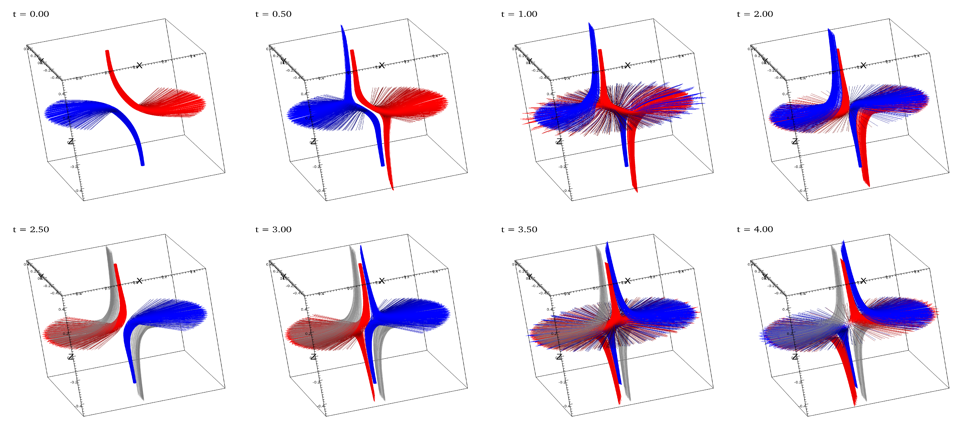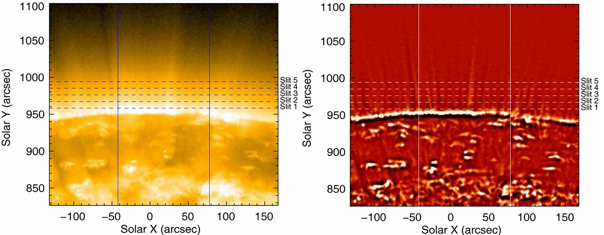My research interests relate to the understanding of energy input, transport and release in the solar atmosphere using theoretical and observational approaches. During my PhD, I developed extensive knowledge of modelling MHD wave behaviour using fully 3D, nonlinear numerical solutions, which I used to investigate the propagation of MHD waves at magnetic null points. Following that, in a postdoctoral post I analysed imaging data for the detection and measurement of MHD waves in the open-field corona, resulting in the first direct measurements of kink waves in coronal plumes. I then expanded my theoretical knowledge to kinetic scales and applied PIC codes to tackle problems relating to electron beam propagation in solar wind plasmas. I currently work on Oscillatory Reconnection, an emerging topic which combines aspects of MHD and plasma wave theory with magnetic reconnection.
Research Highlight: Three-dimensional Oscillatory Magnetic Reconnection

Magnetic reconnection is a fundamental plasma process associated with dynamic energy release, and is believed to explain a broad range of phenomena including solar and stellar flares, coronal mass ejections, astrophysical jets and planetary aurorae. In a paper recently published in The Astrophysical Journal (844, A2, 2017) I report on the finding that magnetic reconnection about a three-dimensional magnetic null point generically involves a self-generated oscillation of the reconnection region provided that it is driven in a finite (but aperiodic) manner (previous models often suppose continuous-driving, prohibiting such effects). Further, I found that an unexpected consequence of this is the periodic generation of a plethora of plasma waves which escape from the vicinity of the reconnection region; including propagating slow modes and torsional Alfvén waves.
The idea of an inherently periodic, time-dependent reconnection mechanism is particularly seductive in the context of being a possible explanation for Quasi-Periodic Pulsations observed in solar and stellar flare emission. Understanding the physical mechanism underpinning this quasi-periodicity is crucial for developing the next generation of flare models and for exploiting these observations as a diagnostic tool, in a similar manner to loops oscillations in coronal seismology. Testing the feasibility of oscillatory reconnection as a physical explanation for QPPs in solar flares is a key aim of my current work.

Research Highlight: First Direct Measurements of Transverse Waves in Solar Polar Plumes


There is intense interest in determining the precise contribution of Alfvénic waves propagating along solar structures to the problems of coronal heating and solar wind acceleration. Since the launch of SDO/AIA, it has been possible to resolve transverse oscillations in off-limb solar polar plumes and recently McIntosh et al. (Nature, 2011, 475, 477) concluded that such waves are energetic enough to play a role in heating the corona and accelerating the fast solar wind. However, their results were based on comparisons to Monte Carlo simulations and confirmation via direct measurement was still outstanding. In a 2014 letter (ApJL, 790, L2) I reported on the first direct measurements of transverse wave motions in solar polar plumes, presenting results of a large statistical sample taken over a 4 hour period. Accounting for the observed parameter distribution I calculated an energy flux which was at least 4- 10 times below the energy requirement for solar wind acceleration. These initial results suggested that transverse MHD waves as resolved by SDO/AIA cannot be the dominant energy source in the open-field corona. A short summary piece on the work is also available at UK Solar Physics. Since the project’s completion, the United States Air Force’s EOARD have since funded a proposal to extend the work as a result of this initial success.
Electron Beams and Radio Emission in Inhomogeneous Plasma
Write something for this!
PhD Project: MHD Waves in the Vicinity of 3D Magnetic Null Points
Both MHD waves and magnetic null points are prevalent in many astrophysical plasmas, including the solar corona, and as such their interaction is inevitable. Prior to my PhD, the current theory implicated coronal null points as locations of localised heating events due to their interaction with MHD waves in the vicinity. However, this work was almost exclusively based on treatments of 2D models, which are significantly different to their 3D counterparts. Since MHD wave behaviour is highly dependent on the magnetic structure of the medium in which it propagates, the extent of applicability to realistic null points, which are necessarily 3D, was unclear.
Thus, my thesis explored the fundamental nature of MHD waves in the vicinity of 3D nulls. This was achieved primarily through modelling using fully 3D, nonlinear solutions of the MHD equations with the LARE3D code (Arber et al., Journal of Computational Physics, 2001, 171, 151) and resulted in three first-author publications on null points, and a further paper on nonlinear Alfvén waves in more generalised geometries. I found that realistic 3D nulls are indeed traps for MHD wave energy, however wave phenomena in their vicinity is much richer due to possible mode coupling, conversion and interaction facilitated by the inhomogeneity of the medium. This interaction impacts on the overall effectiveness of the null as an energy trap; energy contained in fast waves is usually focused at null points, however certain trajectories allow mode conversion to the Alfvén wave, which allows for energy escape. These principles are intimately linked to the theory of ‘resonant absorption’ which is more commonly studied in the context of solar flux tubes.